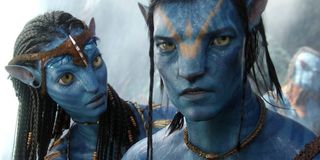Filming Avatar 2’s Underwater Scenes Sounds Ridiculously Hard For James Cameron

It's been nearly a decade since James Cameron delivered Avatar to the public, but the filmmaker has finally moved Avatar 2 out of the development stage and into principal photography. Movie-making technology has improved enough since 2009 that certain aspects of shooting the sequel will be easier than it was with its predecessor, but that doesn't mean there aren't still challenges. For instance, Avatar 2 will spend a lot of time underwater on Pandora, thus adding new visual flair to spice up the story. But as a result, because the Avatar movies rely on the actors wearing suits covered in dots so their movements can be tracked, taking the action into an underwater setting significantly complicates that process. Cameron explained:
It's never been done before and it's very tricky because our motion capture system, like most motion capture systems, is what they call optical base, meaning that it uses markers that are photographed with hundreds of cameras. The problem with water is not the underwater part, but the interface between the air and the water, which forms a moving mirror. That moving mirror reflects all the dots and markers, and it creates a bunch of false markers. It's a little bit like a fighter plane dumping a bunch of chaff to confuse the radar system of a missile. It creates thousands of false targets, so we've had to figure out how to get around that problem, which we did. Basically, whenever you add water to any problem, it just gets ten times harder. So, we've thrown a lot of horsepower, innovation, imagination and new technology at the problem, and it's taken us about a year and a half now to work out how we're going to do it.
So for those of you who have wondered why it's taken so long for Avatar 2 to begin production, evidently figuring out how to overcome the reflection problem with the motion capture dots and markers is at least part of the reason for the delay. That being said, the problem didn't resolve itself right before Avatar 2 began rolling cameras in September. In fact, Cameron noted that the crew only had its first successful underwater run last week. Cameron continued:
We've done a tremendous amount of testing, and we did it successfully, for the first time, just last Tuesday [November 14th]. We actually played an entire scene underwater with our young cast. We've got six teenagers and one seven-year-old, and they're all playing a scene underwater. We've been training them for six months now, with how to hold their breath, and they're all up in the two to four minute range. They're all perfectly capable of acting underwater, very calmly while holding their breath. We're not doing any of this on scuba. And we're getting really good data, beautiful character motion and great facial performance capture. We've basically cracked the code.
James Cameron also mentioned during his interview with Collider that Avatar 2 and Avatar 3 will have a lot of scenes set underwater, though Avatar 4 and Avatar 5 will still include some underwater elements. Because the next two Avatar movies are shooting simultaneously, Cameron and his team will take a break afterwards to carry out post-production on them, and then production on the final two Avatar movies will commence. Judging by the director's comments, it sounds like taking care of these underwater scenes is becoming less of a hassle, so as the years pass, ideally it will become one of the easier aspects of the filming process for Cameron and his team.
Avatar 2 opens in theaters on December 18, 2020, and the next three Avatar sequels will be spread out between 2021 and 2025. Stay tuned to CinemaBlend for more updates on the Avatar franchise, and take a look through our 2018 premiere guide to see what movies will be released next year.
CINEMABLEND NEWSLETTER
Your Daily Blend of Entertainment News

Connoisseur of Marvel, DC, Star Wars, John Wick, MonsterVerse and Doctor Who lore, Adam is a Senior Content Producer at CinemaBlend. He started working for the site back in late 2014 writing exclusively comic book movie and TV-related articles, and along with branching out into other genres, he also made the jump to editing. Along with his writing and editing duties, as well as interviewing creative talent from time to time, he also oversees the assignment of movie-related features. He graduated from the University of Oregon with a degree in Journalism, and he’s been sourced numerous times on Wikipedia. He's aware he looks like Harry Potter and Clark Kent.
Most Popular






